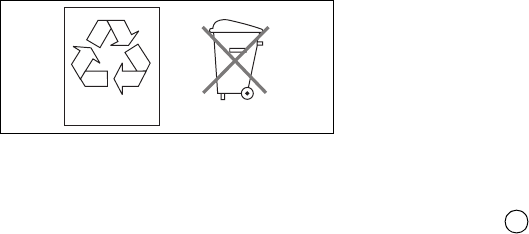
34006452EN/AC - Page 39
Maintenance
8.2 Battery maintenance
8.3 Autodiagnostics
8.4 Visual check
8.5 Functional check
Consult the instructions supplied by the battery manufacturer. Below are a few general indications:
– sealed lead-acid batteries.
These batteries require no maintenance:
but check the terminals of each cell from time to time and clean if necessary;
– vented lead-acid batteries:
check the electrolyte level regularly and add water if necessary,
check the voltage of each cell to determine if it is necessary to equalize the battery,
check the terminals of each cell and clean if necessary.
Caution:
Battery maintenance is undertaken with the system powered up. Operations must be carried out in accordance with applicable
safety regulations by qualified personnel using insulated tools, gloves and safety goggles.
Batteries contain dangerous substances that will harm the environment if thrown away. If you change the batteries yourself,
call on qualified organizations for battery disposal and recycling.
Note the indications supplied on the hidden control panel (lights A to N ). See the "control panel" section.
In systems with one or several alphanumeric displays, check the list of alarms.
If there is a true malfunction, note the indications and alarms and call the after-sales support department.
– after-sales support technicians will power down the system prior to any maintenance operations.
Note:
In redundant, parallel UPS systems and frequency converters, the check may be carried out successively on each UPS or
converter without interrupting the load. In other configurations and for the Static Switch Cubicle, the load must be supplied via
the maintenance bypass (see the "Alarm" section).
– clean the system regularly, particularly the air inlet and outlet grills. Check that the air circulates freely in the cubicles.
– Use a vacuum cleaner if necessary;
– check that nothing hinders the ventilation at the top of the system;
– check that all the fans operate correctly.
– check that lights J, K, M and N on the hidden control panel are not on to avoid an interruption in the supply of power to
the load due to incorrect transfer conditions or a battery problem;
– press the "inverter off" button and check that the buzzer and control panel lights function correctly (see the "main operating
modes" section);
– press the "inverter on" button and check again that the control panel lights function correctly;
– run a transfer to battery test. With the inverter on, open input switch Q1.
The orange "battery" light on the control panel should light. After two minutes on battery power, close input switch Q1.
The rectifier/charger should automatically restart and the orange "battery" light on the control panel should go off;
– in parallel systems, run these tests on each UPS or converter.
Pb Pb
8


















